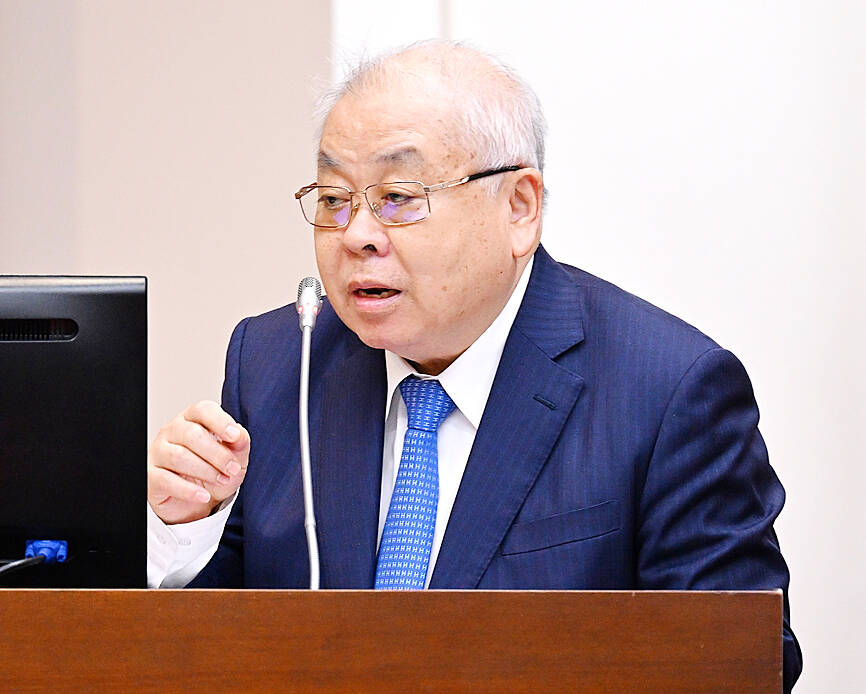Taiwan’s GDP growth this year might surpass last year’s 2.45 percent, despite a slowdown, after taking into consideration a plan to hand out NT$6,000 (US$196.23) to eligible people from last year’s tax surplus and other subsidies, Directorate-General of Budget, Accounting and Statistics (DGBAS) Minister Chu Tzer-ming (朱澤民) said yesterday.
Chu was responding to questions from lawmakers during a review of a NT$380 billion special budget to help boost the economy following the COVID-19 pandemic.
The statistics agency last month trimmed its forecast for GDP growth this year to 2.12 percent, from 2.75 percent, with a 1.2 percent contraction this quarter, Chu said, adding that the forecast did not factor in the special budget funded by last year’s tax surpluses.

Photo: Chu Pei-hsiung, Taipei Times
The upcoming distribution of NT$6,000 for all citizens and permanent residents would raise the GDP reading by at least 0.3 percentage points, while other stimulus programs would lend further support, Chu said.
The Ministry of the Interior is to provide a once-off NT$30,000 mortgage subsidy to low-income households to ease their financial burdens, which have been worsened by inflation and interest rate hikes, the minister said.
Other ministries have also proposed stimulus programs to energize private consumption, the main growth driver this year, as exports and private investment are taking a hit from a global economic slowdown.
Ultimately, this year’s economic growth might be better than last year’s, Chu said.
Democratic Progressive Party Legislator Shen Fa-hui (沈發惠) asked whether inflation would climb further and erode economic benefits after the government raises electricity prices later this year.
Chu said that the statistics agency has not taken into consideration electricity price adjustments, which a panel at the Ministry of Economic Affairs would be tackling late this month.
Electricity rate hikes would surely affect the consumer price index and the DGBAS would revisit the issue in May after policymakers reach a conclusion, Chu said.
Chinese Nationalist Party (KMT) Legislator Lai Shyh-bao (賴士葆) asked Minister of Finance Chuang Tsui-yun (莊翠雲) to shed light on the National Stabilization Fund’s reported exit from the local bourse now that the TAIEX has recovered some ground and the Financial Supervisory Commission has removed bans on short selling.
The TAIEX is hovering around 15,000 points, with a stable daily turnover of more than NT$200 billion, Chuang said, adding that she has confidence in the index’s performance.
The TAIEX yesterday rose 155.09 points, or 0.99 percent, to close at 15,763.51. The benchmark index has risen 11.5 percent since the beginning of this year, Taiwan Stock Exchange data showed.
The National Stabilization Fund’s management committee is to hold a quarterly meeting next month, at which committee members would discuss the fund’s next moves, Chuang said.

The US dollar was trading at NT$29.7 at 10am today on the Taipei Foreign Exchange, as the New Taiwan dollar gained NT$1.364 from the previous close last week. The NT dollar continued to rise today, after surging 3.07 percent on Friday. After opening at NT$30.91, the NT dollar gained more than NT$1 in just 15 minutes, briefly passing the NT$30 mark. Before the US Department of the Treasury's semi-annual currency report came out, expectations that the NT dollar would keep rising were already building. The NT dollar on Friday closed at NT$31.064, up by NT$0.953 — a 3.07 percent single-day gain. Today,

‘SHORT TERM’: The local currency would likely remain strong in the near term, driven by anticipated US trade pressure, capital inflows and expectations of a US Fed rate cut The US dollar is expected to fall below NT$30 in the near term, as traders anticipate increased pressure from Washington for Taiwan to allow the New Taiwan dollar to appreciate, Cathay United Bank (國泰世華銀行) chief economist Lin Chi-chao (林啟超) said. Following a sharp drop in the greenback against the NT dollar on Friday, Lin told the Central News Agency that the local currency is likely to remain strong in the short term, driven in part by market psychology surrounding anticipated US policy pressure. On Friday, the US dollar fell NT$0.953, or 3.07 percent, closing at NT$31.064 — its lowest level since Jan.

Hong Kong authorities ramped up sales of the local dollar as the greenback’s slide threatened the foreign-exchange peg. The Hong Kong Monetary Authority (HKMA) sold a record HK$60.5 billion (US$7.8 billion) of the city’s currency, according to an alert sent on its Bloomberg page yesterday in Asia, after it tested the upper end of its trading band. That added to the HK$56.1 billion of sales versus the greenback since Friday. The rapid intervention signals efforts from the city’s authorities to limit the local currency’s moves within its HK$7.75 to HK$7.85 per US dollar trading band. Heavy sales of the local dollar by

The Financial Supervisory Commission (FSC) yesterday met with some of the nation’s largest insurance companies as a skyrocketing New Taiwan dollar piles pressure on their hundreds of billions of dollars in US bond investments. The commission has asked some life insurance firms, among the biggest Asian holders of US debt, to discuss how the rapidly strengthening NT dollar has impacted their operations, people familiar with the matter said. The meeting took place as the NT dollar jumped as much as 5 percent yesterday, its biggest intraday gain in more than three decades. The local currency surged as exporters rushed to